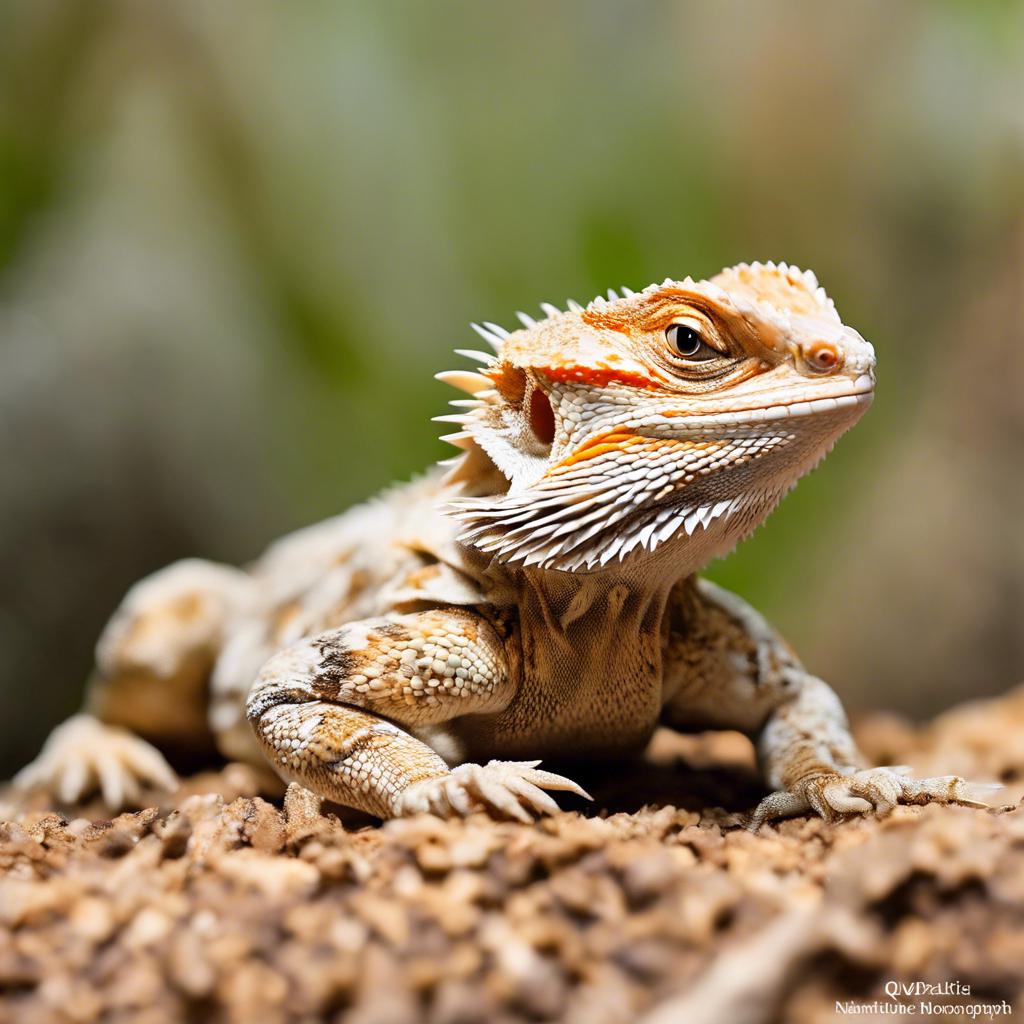Bearded dragons are popular reptile pets known for their unique appearance and docile nature. Native to Australia, these lizards have become increasingly popular as pets due to their low maintenance requirements and friendly demeanor. However, one aspect of bearded dragon care that is often overlooked is substrate selection.
Substrate refers to the material that lines the bottom of the bearded dragon's enclosure. It serves several purposes, including providing a comfortable surface for the dragon to walk on, absorbing waste, and maintaining humidity levels. Choosing the right substrate is crucial for the health and well-being of your bearded dragon.
Key Takeaways
- Bearded dragons require a suitable substrate for their health and well-being.
- Different types of substrates have their own advantages and disadvantages.
- Factors to consider when choosing a substrate include age, size, and behavior of the bearded dragon.
- Best substrates for baby bearded dragons include paper towels and reptile carpet.
- Best substrates for adult bearded dragons include tile and sand mats.
Understanding Different Types of Substrates for Bearded Dragons
There are several types of substrates commonly used for bearded dragons, each with its own advantages and disadvantages. The most common types include sand, newspaper, reptile carpet, and tile.
Sand is a popular choice among bearded dragon owners due to its natural appearance and the fact that it allows the dragon to dig and burrow. However, sand can pose a risk if ingested by the dragon, as it can cause impaction in their digestive system.
Newspaper is a cheap and easy-to-clean option for substrate. It provides a flat surface for the dragon to walk on and makes waste cleanup a breeze. However, it lacks the natural look and feel of other substrates.
Reptile carpet is another popular choice as it is easy to clean and provides a comfortable surface for the dragon to walk on. However, it can be difficult to remove waste from the carpet fibers, leading to odor and hygiene issues.
Tile is a durable and easy-to-clean option that provides a natural look and feel. It also helps maintain humidity levels in the enclosure. However, it can be slippery for the dragon to walk on, especially if it has smooth surfaces.
Advantages and Disadvantages of Different Substrate Types
Each type of substrate has its own set of advantages and disadvantages. Sand, for example, provides a natural and aesthetically pleasing environment for the dragon. It allows them to exhibit their natural digging and burrowing behaviors. However, sand can be a choking hazard if ingested and can cause impaction in the dragon's digestive system.
Newspaper, on the other hand, is a cheap and easy-to-clean option. It provides a flat surface for the dragon to walk on and makes waste cleanup a breeze. However, it lacks the natural look and feel of other substrates.
Reptile carpet is a popular choice among bearded dragon owners due to its ease of cleaning and comfortable surface. However, it can be difficult to remove waste from the carpet fibers, leading to odor and hygiene issues.
Tile is a durable and easy-to-clean option that provides a natural look and feel. It also helps maintain humidity levels in the enclosure. However, it can be slippery for the dragon to walk on, especially if it has smooth surfaces.
Factors to Consider When Choosing a Substrate for Your Bearded Dragon
When selecting a substrate for your bearded dragon, there are several factors to consider. These include cost, ease of cleaning, aesthetics, and the specific needs of your dragon.
Cost is an important factor to consider, as some substrates can be quite expensive. Sand, for example, can be costly if you need to purchase large quantities. On the other hand, newspaper is a cheap option that can be easily replaced when soiled.
Ease of cleaning is another important consideration. Some substrates, such as reptile carpet and tile, are easy to clean and maintain. Others, like sand, require more frequent cleaning and may need to be completely replaced periodically.
Aesthetics may also play a role in your substrate selection. Some owners prefer the natural look and feel of sand or tile, while others may prefer the simplicity of newspaper or reptile carpet.
Finally, it is important to consider the specific needs of your bearded dragon. Some dragons may have sensitivities or allergies to certain substrates, so it is important to research and understand your dragon's needs before making a decision.
Best Substrates for Baby Bearded Dragons
When it comes to baby bearded dragons, certain substrates are better suited for their needs. As young dragons are more prone to impaction, it is important to choose a substrate that minimizes this risk.
Reptile carpet is a popular choice for baby bearded dragons as it provides a comfortable surface for them to walk on and reduces the risk of impaction. It is also easy to clean and maintain, making it a practical option for young dragons.
Paper towels are another suitable substrate for baby bearded dragons. They are cheap, easy to replace, and provide a flat surface for the dragon to walk on. However, they lack the natural look and feel of other substrates.
Best Substrates for Adult Bearded Dragons

As adult bearded dragons are less prone to impaction, there are more options available when it comes to substrate selection. Sand is a popular choice among adult bearded dragon owners as it allows them to exhibit their natural digging and burrowing behaviors. However, it is important to choose a fine-grained sand that is less likely to cause impaction if ingested.
Tile is another suitable substrate for adult bearded dragons. It provides a natural look and feel and is easy to clean and maintain. However, it can be slippery for the dragon to walk on, especially if it has smooth surfaces.
How to Properly Clean and Maintain Your Bearded Dragon's Substrate
Proper cleaning and maintenance of your bearded dragon's substrate is crucial for their health and well-being. Here is a step-by-step guide to help you keep their enclosure clean and hygienic:
1. Remove any solid waste from the substrate daily using a scooper or tongs.
2. Spot clean any soiled areas of the substrate with a reptile-safe disinfectant or mild soap and water.
3. Replace the substrate completely every 2-4 weeks, depending on the type of substrate used and the cleanliness of the enclosure.
4. Regularly clean and disinfect any accessories or decorations in the enclosure, such as rocks or branches.
5. Monitor the humidity levels in the enclosure and adjust as necessary to prevent mold or bacterial growth.
Common Health Issues Caused by Improper Substrate Use
Using the wrong substrate can lead to a variety of health problems for your bearded dragon. The most common issue is impaction, which occurs when the dragon ingests substrate material that cannot be digested and becomes lodged in their digestive system. This can lead to blockages, constipation, and even death if not treated promptly.
Another common health issue is respiratory problems caused by dusty substrates, such as sand or wood shavings. Inhaling these particles can irritate the dragon's respiratory system and lead to respiratory infections.
Skin irritation is also a concern with certain substrates, such as rough sand or reptile carpet with loose fibers. These can cause abrasions or sores on the dragon's skin, leading to infection if not addressed.
Tips for Preventing Substrate-Related Health Problems in Bearded Dragons
To prevent substrate-related health issues in your bearded dragon, it is important to be proactive and vigilant. Here are some practical tips to help keep your dragon healthy:
1. Research and understand your bearded dragon's specific needs before selecting a substrate.
2. Choose a substrate that minimizes the risk of impaction, especially for baby dragons.
3. Regularly clean and maintain the substrate to prevent the buildup of waste and bacteria.
4. Monitor your dragon's behavior and health closely, and seek veterinary care if you notice any signs of illness or discomfort.
5. Provide a variety of surfaces and textures in the enclosure to stimulate natural behaviors and prevent boredom.
Conclusion and Final Thoughts on Bearded Dragon Substrate Selection and Care
Choosing the right substrate for your bearded dragon is crucial for their health and well-being. It is important to consider factors such as cost, ease of cleaning, aesthetics, and the specific needs of your dragon when making a decision. Regular cleaning and maintenance of the substrate are also essential to prevent health issues.
By understanding the different types of substrates available and their pros and cons, you can make an informed decision that will provide a comfortable and safe environment for your bearded dragon. Remember to monitor your dragon's behavior and health closely, and seek veterinary care if you notice any signs of illness or discomfort. With proper substrate selection and care, your bearded dragon can thrive and live a long, healthy life.
If you're looking for more information on what substrate is best for bearded dragons, you might find this article from Reptile Wizard's blog helpful. They provide valuable insights and recommendations on choosing the right substrate for your bearded dragon's habitat. From discussing the pros and cons of different options to highlighting the importance of safety and hygiene, this article covers it all. Check it out here to ensure you're providing the best possible environment for your scaly friend.
FAQs
What is a substrate?
A substrate is the material that lines the bottom of a bearded dragon's enclosure.
Why is choosing the right substrate important for bearded dragons?
Choosing the right substrate is important for bearded dragons because it can affect their health and well-being. The wrong substrate can cause impaction, respiratory problems, and other health issues.
What are some common substrates for bearded dragons?
Some common substrates for bearded dragons include reptile carpet, paper towels, newspaper, tile, and certain types of sand.
Is sand a good substrate for bearded dragons?
Some types of sand can be a good substrate for bearded dragons, but it is important to choose a sand that is fine-grained and does not contain any sharp particles. Calcium sand should be avoided as it can cause impaction.
What is the best substrate for bearded dragons?
The best substrate for bearded dragons is a matter of personal preference and can depend on the individual dragon's needs. Reptile carpet, paper towels, and tile are all good options that are easy to clean and do not pose a risk of impaction.

